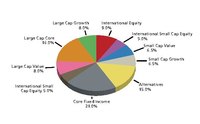
Photo from wikipedia
This study develops three capital allocation approaches and a directional weight increment algorithm to identify the efficient frontier of all possible multi-asset portfolios precisely and rapidly. Subsequently, this study proposes… Click to show full abstract
This study develops three capital allocation approaches and a directional weight increment algorithm to identify the efficient frontier of all possible multi-asset portfolios precisely and rapidly. Subsequently, this study proposes an asset selection criterion, based on the coefficient of variance and volatility risk measures, to perform the asset allocation for two types of investors who are willing or not willing to bear the risk. Finally, this study uses a multivariate generalized autoregressive conditional heteroskedasticity (GARCH) model to estimate the conditional variance and covariance of several multi-asset portfolios constituted of seven assets dispersed in the oil, stock, and currency markets of the US. The empirical results show that, via applying the proposed asset selection criterion, the most suitable multi-asset portfolios are the SP500-Nasdaq and the GasNyh-DJ, which belong to the relatively most efficient portfolios. Moreover, two capital allocation approaches using the entire sample weight forecasts have the best forecast performance. Additionally, for all multi-asset portfolios the weight combination set of portfolios on the efficient frontier that resulted from the proposed algorithm is consistent with that obtained from the traditional approach.
Journal Title: Sustainability
Year Published: 2020
Link to full text (if available)
Share on Social Media: Sign Up to like & get
recommendations!